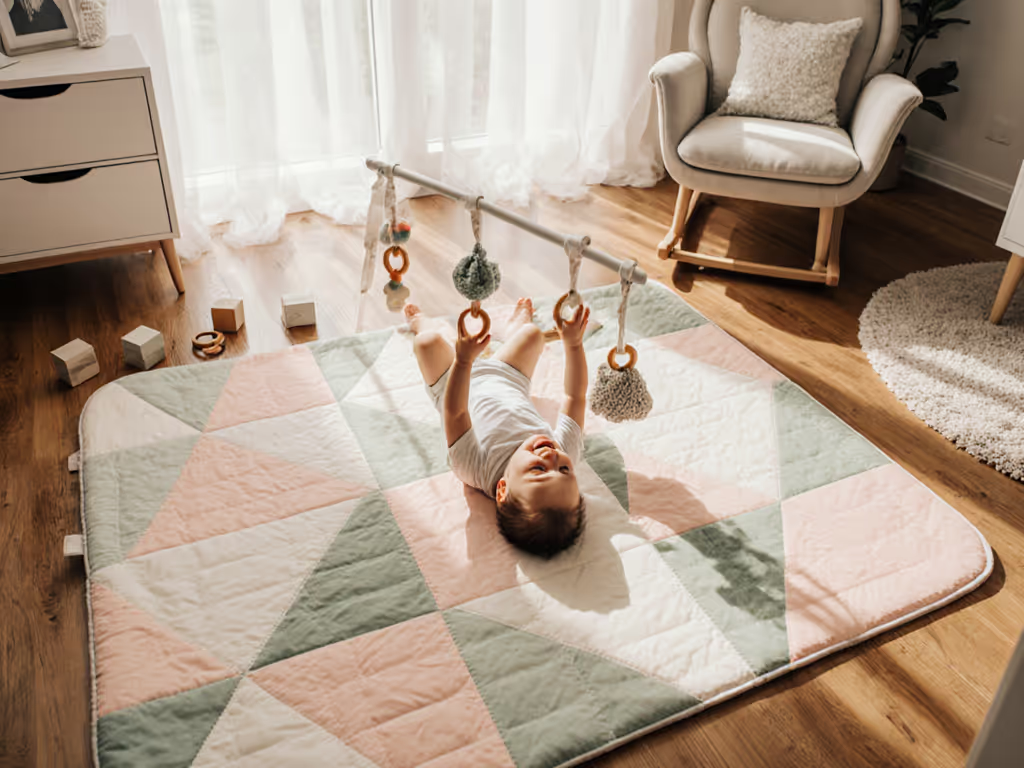
Play Mat Safety Standards Explained: Essential Guide

Over 90 percent of parents feel anxious about choosing safe products for their children. Every play mat promises comfort, but not all meet the strict standards designed to keep little ones truly protected. Understanding play mat safety standards empowers you to spot hidden dangers and ensures you create a secure space where your child can play, crawl, and learn with peace of mind.
Key Takeaways
| Point | Details |
|---|---|
| Importance of Safety Standards | Play mat safety standards are essential for ensuring that the playing surface is free from hazards, protecting children during play. |
| Material Awareness | Parents should prioritize play mats made from non-toxic materials and check for safety certifications to ensure low chemical emissions. |
| Types of Play Mats | Different types of play mats (foam, rubber, fabric) each have unique benefits and potential drawbacks that should align with your child's needs. |
| Recognizing Risks | Be vigilant about risks like chemical off-gassing and structural hazards, and take preventive measures to create a safe play environment. |
What Are Play Mat Safety Standards?
When it comes to protecting your little ones, play mat safety standards are much more than just bureaucratic paperwork. These are carefully designed guidelines that ensure the surface where your child spends countless hours playing is free from potential hazards. Safety standards act like an invisible shield, screening out risks that might not be immediately apparent to the naked eye.
Play mat safety standards typically cover several critical areas of concern. The European Standard EN 71 provides a comprehensive framework that examines multiple dimensions of potential risk, including:
- Mechanical properties: Checking for sharp edges, small detachable parts, or structural weaknesses
- Chemical composition: Screening for toxic substances and harmful materials
- Flammability: Ensuring materials resist catching fire or burning quickly
- Toxic element migration: Preventing harmful chemicals from leaching out during use
Globally, different regions have developed their own robust safety certifications. For instance, the China Compulsory Certification (CCC) mandates compliance with standards like GB 6675, which similarly evaluates play mats through rigorous mechanical and chemical testing. These standards aren't just optional recommendations - they represent a critical layer of protection between your child and potential environmental risks.
Understanding these standards empowers parents to make informed choices. When shopping for a play mat, look for clear certifications and ask manufacturers about their compliance with recognized safety protocols. Remember: a truly safe play mat isn't just about comfort, but about creating a secure environment where your child can explore, learn, and grow without unnecessary risks.
Types of Play Mats and Key Differences
Choosing the right play mat involves understanding the diverse landscape of materials, designs, and safety considerations. Foam play mats have long been a popular choice for parents, offering cushioned protection for infants and toddlers during their exploratory stages. These mats come in various thicknesses and provide a soft landing surface for those inevitable tumbles and learning-to-move moments.
Play mats can be categorized into several primary types, each with unique characteristics:
-
Foam Mats: Lightweight, cushioned, and often interlocking
- Pros: Soft, affordable, easy to clean
- Cons: Potential chemical off-gassing, less durable long-term
-
Rubber Play Mats: More robust and typically used in outdoor or high-impact areas
- Pros: Extremely durable, water-resistant, shock-absorbing
- Cons: Heavier, less portable, potentially higher cost
-
Fabric/Quilted Play Mats: Soft textiles designed for comfort and aesthetic appeal
- Pros: Washable, decorative, often more natural materials
- Cons: Less impact protection, can absorb stains more easily
Parents should pay special attention to material composition. Research from childcare experts highlights potential concerns with foam play mats, which might contain chemicals like formamide and volatile organic compounds (VOCs). When selecting a play mat, prioritize certifications that confirm low chemical emissions and compliance with safety standards. The goal isn't just cushioning - it's creating a safe, healthy environment for your child's development.
Ultimately, the best play mat depends on your specific needs. Consider factors like your child's age, play area, cleaning requirements, and potential movement or crawling stages. A versatile play mat adapts to your child's growth, providing protection and comfort through multiple developmental milestones.
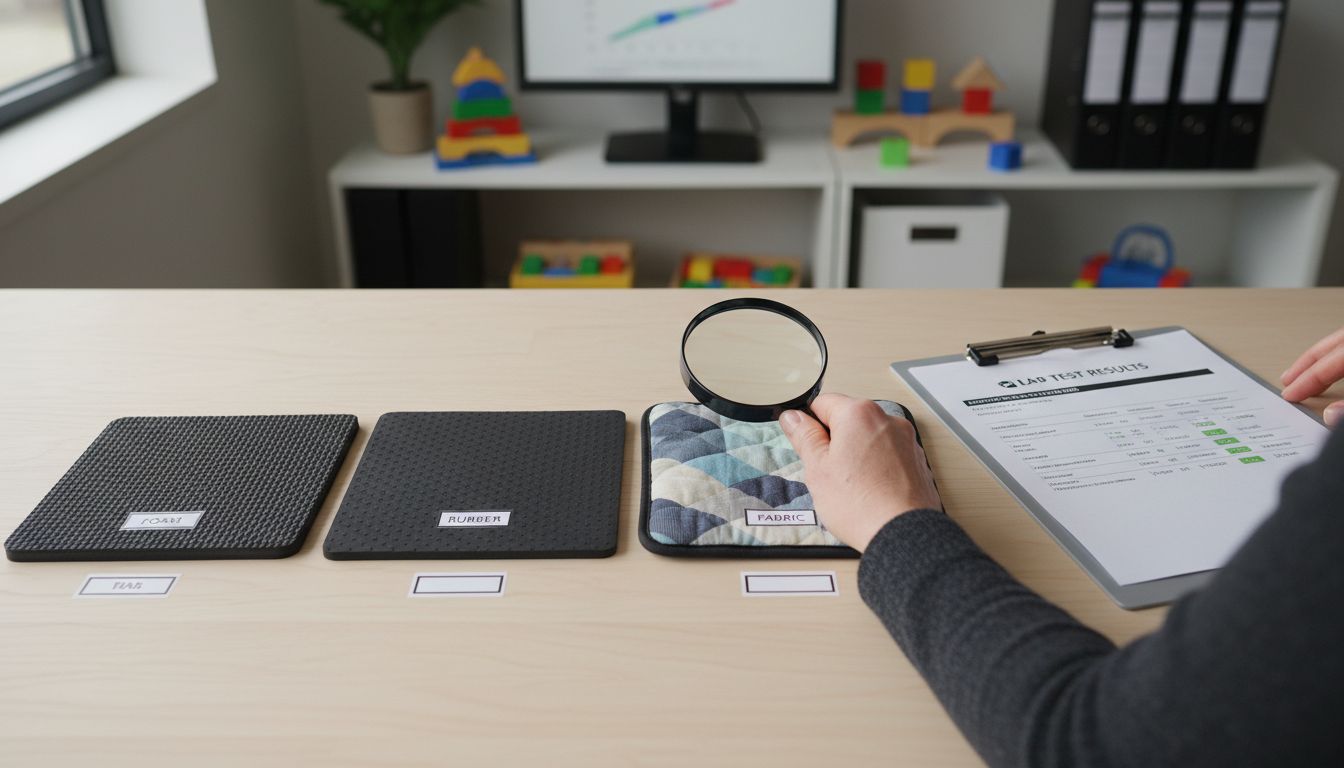
Essential Safety Features and Certifications
When it comes to protecting your child, not all play mats are created equal. Safety certifications serve as your primary defense against potential hazards, acting like a comprehensive shield that guards against unseen risks. These certifications go far beyond simple marketing claims, representing rigorous testing and meticulous quality control processes that ensure your child's play environment remains secure.
Key safety features to look for in a high-quality play mat include:
- Non-Toxic Materials: Ensure the mat is free from harmful chemicals like phthalates, lead, and formaldehyde
- Non-Slip Surface: Prevents accidental sliding and reduces fall risks
- Hypoallergenic Construction: Minimizes potential allergic reactions
- Seamless Design: Eliminates potential choking hazards from loose edges or detachable parts
- Easy-to-Clean Surface: Allows for thorough sanitization and maintenance
Certification standards provide parents with crucial reassurance. Look specifically for independent testing certifications such as ASTM International, European Standard EN 71, and regional safety marks like CCC (China Compulsory Certification). These credentials indicate that the play mat has undergone extensive evaluation for mechanical strength, chemical safety, and overall structural integrity. Reputable manufacturers will readily provide documentation demonstrating their compliance with these stringent standards.
Beyond certifications, consider additional safety nuances that might not be immediately visible. Thickness matters - a mat between 1/2 to 3/4 inches offers optimal cushioning without compromising stability. Edges should be beveled to prevent tripping, and the material should maintain its protective properties even after repeated use and cleaning. Think of a great play mat as more than just a surface - it's a carefully engineered safety zone designed to support your child's exploration and growth while minimizing potential risks.
Global Regulations for Play Mat Safety
Navigating the complex world of play mat safety regulations can feel like traversing an international maze. Global safety standards are not uniform, but instead represent a patchwork of regional requirements designed to protect children across different countries and manufacturing environments. These regulations serve as critical guardrails, ensuring that play mats meet minimum safety thresholds regardless of their point of origin.
Different regions have developed unique yet comprehensive regulatory frameworks:
-
European Union (EU): EN 71 Standard
- Covers mechanical and physical properties
- Evaluates chemical composition
- Strict flammability requirements
- Applies to all toy-related products, including play mats
-
China: China Compulsory Certification (CCC)
- Mandates GB 6675 standard compliance
- Examines mechanical properties
- Tests for toxic element migration
- Requires mandatory product certification
-
United States: Consumer Product Safety Improvement Act (CPSIA)
- Regulates lead and phthalate content
- Mandates third-party testing
- Focuses on chemical safety and material composition
While these regulations might seem complex, they represent a global commitment to child safety. Each standard approaches protection from slightly different angles - mechanical integrity, chemical composition, flammability - but shares a fundamental goal of minimizing potential risks.
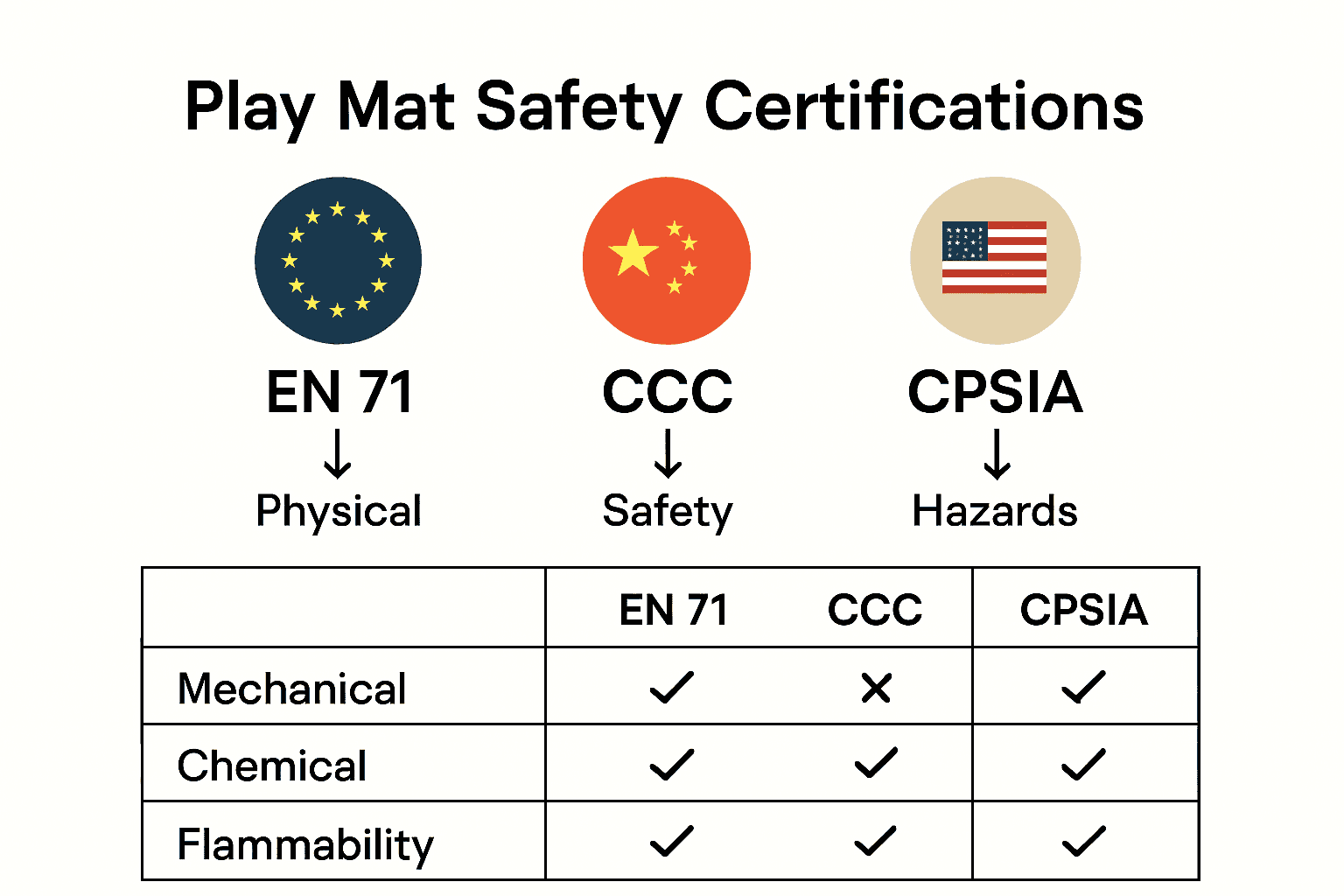 Manufacturers must not only comply with local regulations but increasingly must meet international standards to compete in a global marketplace.
Manufacturers must not only comply with local regulations but increasingly must meet international standards to compete in a global marketplace.
For parents, understanding these regulations transforms shopping from a simple purchase to an informed decision. Always request certification documentation, ask about testing procedures, and look for transparent manufacturers who voluntarily exceed minimum safety requirements. Remember, a truly safe play mat is an investment in your child's health and well-being, transcending bureaucratic checklists to provide genuine protection.
Common Risks and Mistakes to Avoid
Choosing a play mat isn't just about finding a soft surface - it's about creating a safe environment that protects your child from potential hidden dangers. Chemical risks and subtle design flaws can transform what seems like an innocent play area into an unexpected hazard zone. Understanding these risks is the first step in making an informed, protective choice for your little one.
Key risks parents should be vigilant about include:
-
Chemical Off-Gassing
- Foam mats can release volatile organic compounds (VOCs)
- Potential exposure to harmful chemicals like formamide
- Strong chemical odors indicate potential toxicity
-
Structural Hazards
- Small, detachable parts that pose choking risks
- Edges with sharp corners or rough surfaces
- Mats that deteriorate quickly under regular use
-
Environmental Concerns
- Lack of proper ventilation when using new mats
- Inadequate cleaning and sanitization
- Exposure to direct sunlight or extreme temperatures
Consumer studies have revealed alarming findings about play mat safety. Research from the Consumer Council highlighted that some foam play mats can release harmful chemicals and contain small parts that potentially detach, creating significant choking hazards. To mitigate these risks, experts recommend thoroughly vetting play mats before purchase and taking proactive safety measures.
Mitigation strategies are straightforward but crucial. Always air out new mats in well-ventilated spaces before use, inspect them regularly for wear and tear, and choose products specifically labeled as low VOC or formamide-free. Look for certifications from reputable safety organizations, and don't hesitate to ask manufacturers detailed questions about material composition and testing procedures. Your vigilance can transform a potential risk into a safe, nurturing play environment.
Make Safety Your Child's First Playground Priority
Choosing a play mat is about more than just softness or colors. This article highlights critical challenges such as chemical off-gassing, toxic element migration, and unclear safety certifications that put children at risk even when parents think they are providing a safe environment. You want a play mat that not only cushions every tumble but also meets trusted standards like EN 71 or CCC to protect your child from hidden dangers.
At FloorBloom, we understand the emotional need to create a secure, healthy space where your newborn can roll freely and your toddler can cartwheel confidently without worries. Through transparent testing and real-home guidance, we help families select beautiful, non-toxic, and durable play mats that stand up to everyday life and rigorous safety demands. Don’t wait until safety concerns become an issue. Visit FloorBloom now and find the perfect mat that brings peace of mind today and long-lasting protection tomorrow.
Frequently Asked Questions
What are play mat safety standards?
Play mat safety standards are guidelines designed to ensure that play mats are free from potential hazards. These standards typically cover mechanical properties, chemical composition, flammability, and toxic element migration to protect children during play.
How can I identify if a play mat meets safety standards?
Look for certifications and labels from reputable safety organizations indicating compliance with standards like ASTM International or EN 71. Manufacturers should also provide documentation on testing for mechanical strength and chemical safety.
What types of play mats are available and how do they differ?
There are several types of play mats including foam mats, rubber mats, and fabric/quilted mats. Foam mats are lightweight and cushioned, rubber mats are durable and shock-absorbing, while fabric mats offer comfort and aesthetic appeal but less impact protection.
What are the common risks associated with play mats?
Common risks include chemical off-gassing from foam mats, structural hazards like small detachable parts that pose choking risks, and environmental concerns such as inadequate ventilation and lack of cleaning. It’s important to inspect mats regularly and prioritize low VOC or non-toxic options.
Related Articles

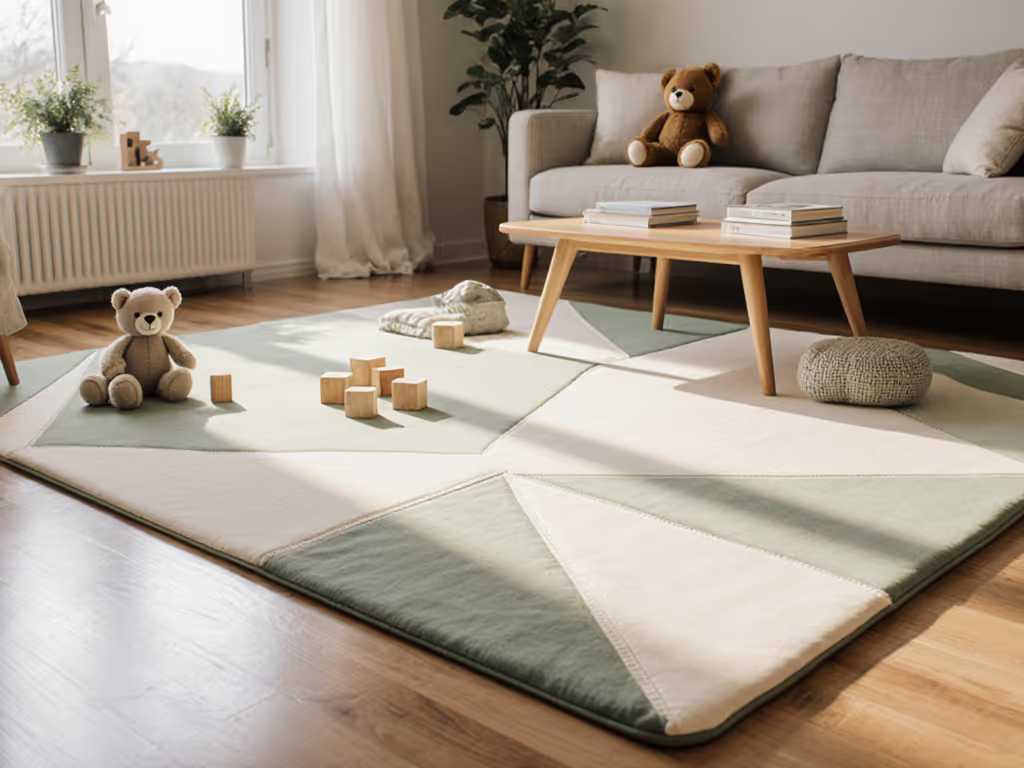
Complete Guide to the Role of Play Mats

7 Essential Play Mat Features Every Parent Should Know
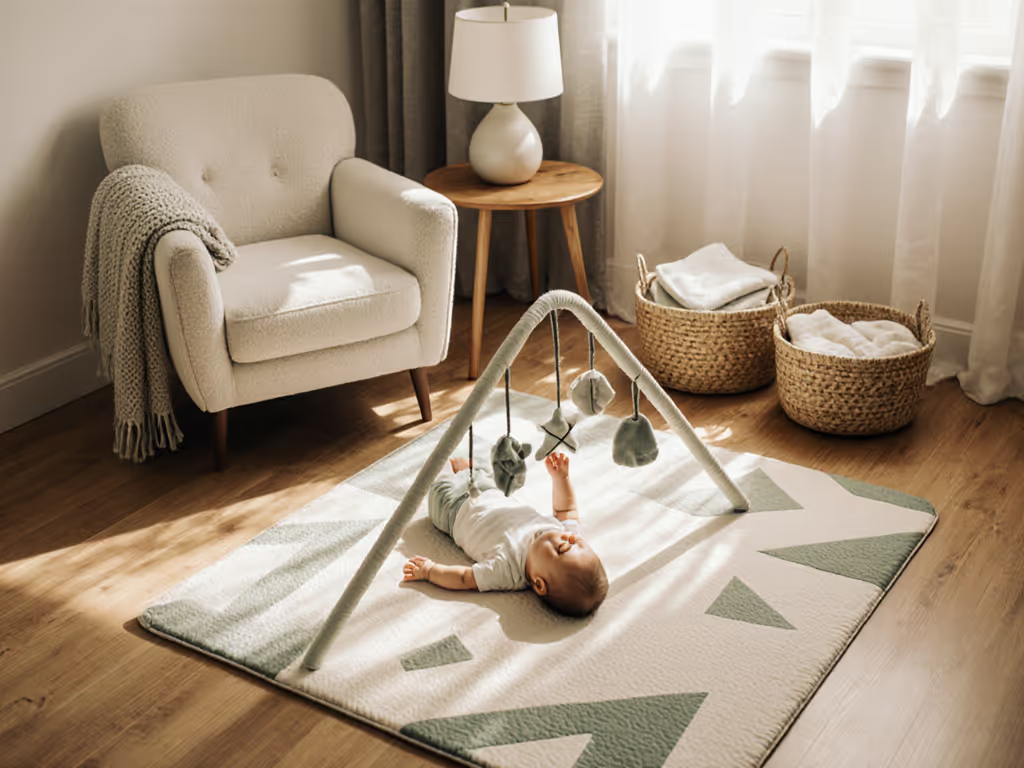
Play Mats for Newborns: Complete Parent Guide
